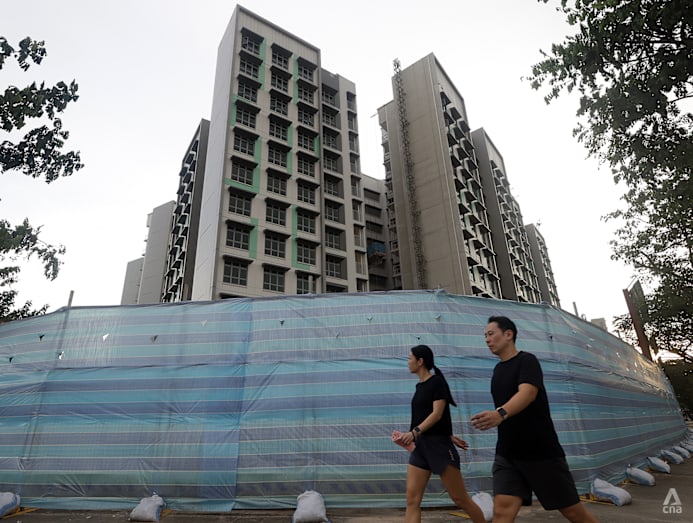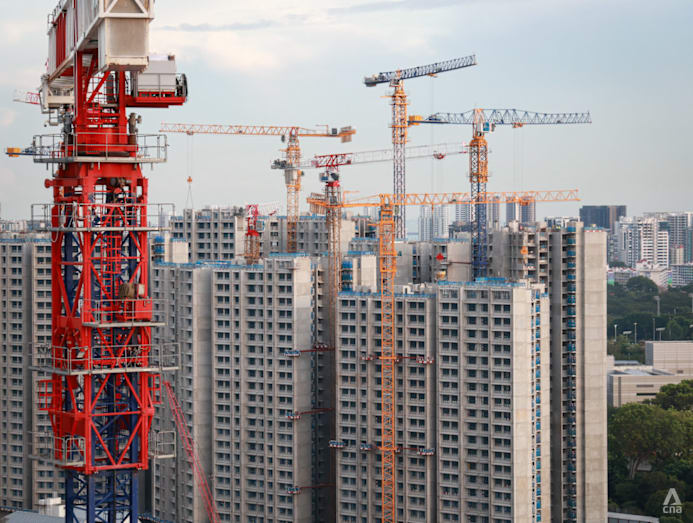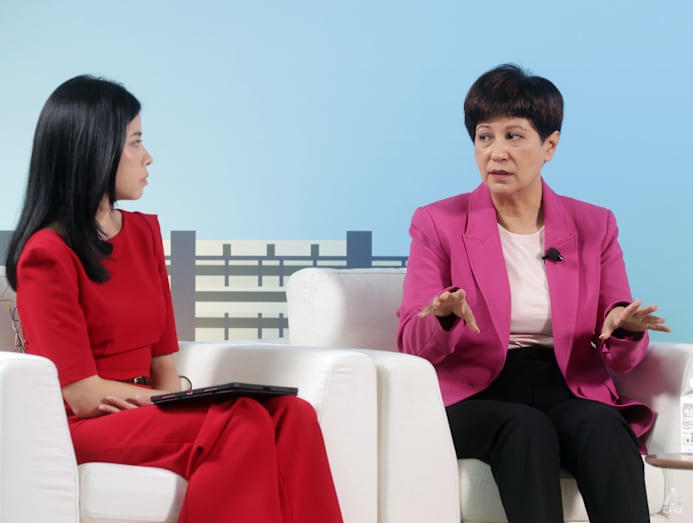When dreams meet reality: Can BTO flats continue to meet buyers' rising expectations and what are the trade-offs?
Affordable, in a central location and with good amenities – people want it all when selecting their Build-To-Order flat. Even as the Housing and Development Board works to meet the growing demands of homebuyers, young couples and singles also have to weigh their wants versus their needs, experts say.

Young Singaporeans view owning a BTO flat as a key milestone but face challenges balancing affordability, location and long construction waits alongside their wants. (Illustration: CNA/Nurjannah Suhaimi)

This audio is generated by an AI tool.
This article is written in partnership with the Housing and Development Board.
While waiting for their four-room Build-to-Order (BTO) flat in Yishun to be completed, Ms Tay Yu Yan and her husband would occasionally receive pictures from family members passing by the construction site, updating them on its progress.
Her future neighbours would also share pictures of the site in a Telegram group, so they could all watch the plot of grassland become the housing estate they would call home. It all added to the sense of excitement and anticipation.
But nothing topped the elation that she and her husband felt when they finally received the keys to their first home earlier this year, and set foot in their BTO.
"Like most young couples, we definitely want our own space as well … it's a milestone moment to get your first home," said the senior marketing executive. She and her 28-year-old husband got married last year.
It was a happy moment for the couple, even though the unit was not their first choice.
They had initially hoped to secure a BTO flat in Kovan near both their parents and situated in a neighbourhood they had grown up in, which also has amenities such as a mall and an MRT station.
They had tried for a flat at Kovan Wellspring in August 2021, but did not receive a queue number in the oversubscribed estate. Resale homes in the area were also too pricey for the couple.
Eventually, the couple balloted for the Yishun flat in February 2022, after considering their budget and the time it would take to build the estate. Their flat cost them about S$350,000 (US$268,000).
Although the flat they have bought comes with some compromise, the couple are taking it in their stride, as the Yishun estate was finished earlier than Kovan Wellspring, which is estimated to be completed in the third quarter of 2026.
"Our intention when we chose this flat (was) that it may be temporary. We might sell later on for a home that is more convenient and accessible, but a four-room flat is also comfortable should we decide to have kids," Ms Tay told CNA TODAY.
This is, for many young Singaporeans, one of the major steps in their "adulting" process – navigating the BTO system, choosing the best possible first home and making a hefty financial commitment, all while riding the joys and compromises this journey can involve.
Several young couples and singles told CNA TODAY that they all hope to become homeowners – unsurprising in a country with one of the world's highest home ownership rates of 90.8 per cent.
In fact, it is a hope that has even shaped romance in Singapore. Many young couples are using BTOs as a proxy engagement ring by popping the question “BTO ai mai?", which loosely translates to: "Want to apply for a BTO flat together?" in Hokkien.

Many of the young couples noted that as with many aspects of adulting, buying a BTO flat can be a daunting task that includes figuring out their budget, the various priority schemes and grants they are eligible for, balancing their needs and wants, applying for a sales launch and selecting a flat.
Over the years, BTO projects have also received their fair share of criticism: that flats are becoming more expensive, wait times for completion can sometimes be very long, and that newer estates in less established neighbourhoods lack food options and amenities.
Add to that the fact that the BTO system can feel like the lottery – success is largely the luck of the draw, as queue numbers for applicants are allotted via a balloting system, and getting a home in a central location could mean receiving a large financial windfall in future, if the buyers decide to sell the flat.
In response, the Housing and Development Board (HDB) has taken steps over the years to address concerns raised by homebuyers.
For one thing, the government is committed to making sure that housing remains affordable, said Minister in the Prime Minister's Office Indranee Rajah.
Ms Indranee, who is also Second Minister for National Development and Finance, was speaking at a panel titled "Balancing expectations and reality: Navigating your first home purchase" on Nov 15 organised by CNA TODAY and HDB.
HDB also introduced a new classification system last year, which categorises new BTO flats as Standard, Plus and Prime, to make BTOs more equitable by attaching extra conditions for flats in choicer locations.
Some of these extra conditions include a 10-year minimum occupancy period (MOP), subsidy recovery upon the resale of the flat and eligibility conditions for resale buyers.
Then, there is also the Family Care Scheme (FCS) to enhance priority for parents and children to live near or with each other, which was implemented this year.
However, whether these initiatives are enough to assuage the concerns of would-be homeowners remains to be seen.
WHAT MAKES A DREAM HOME?
Ask Mr Chen Ji Si, 26, what his ideal HDB flat would be, and his reply would be a unit somewhere central in a mature estate such as Redhill.
The neighbourhood would ideally have key amenities such as a supermarket and MRT station, with a variety of food options, a heartland atmosphere and a strong sense of community. His partner would also want a primary school nearby as the couple hopes to have children.
"I have been to some friends' BTOs in estates in Tengah, where there is little variance in landscape and is just street after street of high-rise housing. But in more mature estates, there's variance in buildings, you can sense the vibes of people living here," said the Singapore Management University student.
"There's a very obvious community living in the neighbourhood."
Mr Chen applied for a BTO in Bukit Merah in the October 2025 sales launch with his 25-year-old girlfriend, who works in the media industry. He is waiting to see if his attempt will succeed.
Similarly, many other young couples have an ideal first home in mind – but sometimes, reality has other plans for them.
Civil servant Melvin Ang, 28, initially wanted to buy a five-room BTO flat in a central location and near an MRT station. He wants a larger unit so he can host friends and family.
But after doing their sums, he and his 24-year-old girlfriend decided to apply for a five-room unit in Choa Chu Kang during the October 2023 BTO sales launch. Their flat is due to be completed in 2028.
Although they could have bought a resale HDB flat in a central location that was large enough for their needs, Mr Ang said the total costs would have exceeded his budget once renovation expenses were included.
Like Mr Ang, Mr Chen and his girlfriend also chose the BTO route because of price considerations.
"Our parents also encouraged us to apply as soon as possible," he said, as they saw that BTO prices had been rising over the years and are continuing to climb.
Prices of four-room flats at Redhill Peaks, one of the housing estates Mr Chen had applied for in the October 2025 launch, ranged from S$541,000 to S$778,000 before grants.
The same sales launch featured lower-priced four-room flats in Yishun, ranging from S$343,000 to S$415,000. Some five-room flats, such as Sengkang's Fernvale Plains, were priced from S$466,000 – cheaper than the four-room flats being sold at a central location.

Ms Indranee explained during the panel session that BTO prices are affected by the flats’ locations and the surrounding amenities.
"You've got one HDB precinct here, another HDB precinct here, but this one happens to have MRT, preschool, schools, whatever, and this one not so much. You're going to have a variation (in price)," she said.
She added that while BTO prices are influenced by the market and resale flat prices, the government provides significant market discounts. This reduces the price of BTO units and makes them often more affordable than resale flats.
"We benchmark (BTO prices) to market, and the market is the resale market. But to make it affordable, we apply that discount… Then, there's a whole range of other things, which is what makes housing in Singapore affordable," she said.
These include grants such as the Enhanced Central Provident Fund Grant, as well as CPF savings, which people can tap to pay for their flats.
"But the bottom line in terms of affordability is to look and see what proportion of your household income, or what they call the mortgage servicing ratio, (goes into paying your home loan)," said Ms Indranee.
She noted that in Singapore, most people's mortgage servicing ratio is around 25 per cent, lower than the international benchmark of about 30 to 35 per cent of monthly income.
WHY LABELS MATTER
The new classification of BTOs as Standard, Plus and Prime is among the steps HDB has taken to make housing more accessible and affordable, said Ms Indranee during the panel session.
First announced by then-Prime Minister Lee Hsien Loong at the National Day Rally on Aug 20, 2023, HDB replaced the old “mature" and "non-mature” estate labels with a location-based classification of BTO projects, effective from the October 2024 sales exercise.

Whether a flat is classified as Standard, Plus or Prime is based on locational attributes such as proximity to the city centre, transport connectivity and availability of amenities.
Choicer locations classified Plus or Prime will receive more subsidies and significant market discounts, but these flats are also subject to tight sales conditions such as a 10-year wait before they can be sold. Previously, all BTO flats were subjected to five-year wait times, except for those classified under the Prime Location Public Housing model.
Prime flats, which are in towns near the city centre, are the most highly subsidised. Owners will have to pay back a portion of the subsidies if they sell the flat.
Such flats can also be sold only to buyers who meet HDB's BTO eligibility criteria, including the income ceiling, currently set at S$14,000 a month for couples and S$7,000 a month for singles.
The Ministry of National Development (MND) and HDB had said earlier that the conditions applying to the classification would "mitigate windfall gains and ensure equity with other flat owners who do not enjoy these additional subsidies".
Since October last year, there have been three other BTO sales, in February, July and October 2025. Experts noted that based on the application rates for these four BTO sales exercises, Plus and Prime projects remain the top choices for first-timer families.
"At the end of the day, location still matters the most. Being close to MRT stations, the Central Business District, job nodes and established amenities is a major draw, strong enough that most couples are willing to look past the longer MOP and tighter resale rules," said Mr Luqman Hakim, the chief data officer of property firm 99.co.
He noted that the 10-year MOP and resale restrictions are often unimportant for people who "genuinely want to live there rather than those hoping to sell quickly for a profit".
However, it is too early to assess how the new classification will impact the broader housing market as most people who have bought these homes have yet to collect their keys, experts noted.
Mr Lee Sze Teck, senior director of data analytics at Huttons Asia, said that it is plausible that the Prime and Plus classifications could push resale prices higher in future.
"The new classification creates an even clearer delineation of expensive and affordable flat clusters. Furthermore, the longer MOP of 10 years will create a supply vacuum for some years," he said, noting that most Plus and Prime BTO projects will fulfil their MOP only in 2038.
But at the same time, HDB is increasing the supply of BTO flats, launching 100,000 flats between 2021 and 2025.
And Ms Indranee said that HDB plans to launch another 55,000 flats between 2025 and 2027, while also reducing the time for units to be built.
"So by injecting more, it will help to increase the supply, moderate the demand and hopefully adjust prices," she said.

SUPPORT FOR SINGLES
To be sure, young couples are not the only ones dreaming of acquiring their own homes.
The latest HDB Sample Household Survey, published on Thursday (Nov 27), showed that the majority of singles who intend to move out of their current homes would prefer to purchase a new home, rather than rent or live with other people.
Of the singles surveyed who have no clear plans of getting married, 72.3 per cent intended to buy a housing unit.
Some 46.5 per cent would opt for new public or private housing units over purchasing a resale unit. According to HDB, these singles cited affordability concerns and desire for newer living environments as key reasons.
Singapore's community of singles is growing, and HDB has over the years amended its policies to better meet the housing needs of this group.
Last year, for example, HDB removed restrictions that limited singles to buying two-room BTO flats only in non-mature estates. Since October last year, singles aged 35 and above have been able to purchase two-room BTO flats island-wide.
Singles can also buy from the resale market two-room Prime flats, all flat types under the Standard and Plus classifications, as well as all flat types not under the new classification. However, they are not eligible for 3Gen flats, which are designed for multi-generational families.
Besides that, singles are also eligible for the Family Care Scheme (FCS) – a two-pronged scheme that allows both married and single children to apply for homes near their parents, and to apply for housing with their parents. This was announced by Prime Minister Lawrence Wong at the National Day Rally 2024.
FCS (Proximity) allows parents and their children, regardless of marital status, priority access if they are applying for a new flat to live with or near each other. A percentage of homes is put aside for people applying through the scheme, which began from the July 2025 sales exercise.
FCS (Joint Balloting), which kicked in from the October 2025 sales launch, allows parents and their children, regardless of marital status, to jointly apply for two units in the same BTO project, where there are two-room flexi or three-room flats in the project.
With these schemes opening up more two-room BTOs to singles, applications among this group have risen, said Ms Christine Sun, chief researcher and strategist of Realion Group, adding that it will take a while for application numbers to stabilise.
In a parliamentary reply on Oct 15, MND said that two in 10 first-timer singles who applied under FCS (Proximity) during the July 2025 BTO sales launch received a queue number. In contrast, six in 10 first-timer families received a queue number in the same exercise through the scheme.
"This reflects the much tighter competition among singles, particularly for smaller units in mature estates where demand is high and supply is limited," Mr Luqman said.
"The share of available units they can realistically secure remains smaller than that of families."

While these initiatives have opened up more housing options, singles whom CNA TODAY spoke to said their biggest pain point is the eligibility age to apply for a BTO or purchase a resale flat.
Mr He Shuming, 39, has attempted to buy a flat thrice, including applying for a Sales of Balance Flat. He applied for a two-room BTO flat in the recent October 2025 sales launch.
"I think that people at 30 should be able to purchase their own homes as long as they have the financial means to do so," he said.
While he wants a flat that is accessible but located in a quiet vicinity, Mr He said he knows it'll be difficult to get such a unit, given the high demand for homes in central locations.
He also wishes singles could have access to three-room BTO flats, which he said would be a good size to have both a bedroom and a workspace. Resale prices are too steep, he told CNA TODAY.
"If you're single, it is unfair to buy a five-room flat and take the chance away from a family who needs it. But a three-room flat, why not?"
BALANCING ACT AMID COMPETING DEMANDS
Ms Indranee noted during the panel session that there is a "delicate balance" in meeting the housing needs of young couples, seniors and singles. At the same time, Singapore has to contend with a finite supply of land and space.
When asked how to determine which group has a greater housing need, Ms Indranee noted that young families or couples are prioritised because "they're just starting out, they need a home of their own, and many of them would like to start families".
She added that people who want to be near family members, such as to care for ageing parents, are also prioritised under the Family Care Scheme.
"So you can see that what we're doing is we're giving priority to family formation," she said. "There may be some others we give priority to, (but) that's a way of sorting out the demand."
Beyond that, Ms Indranee said that HDB has been reviewing the income ceiling of BTO flats and eligibility age for singles – something that National Development Minister Chee Hong Tat also highlighted in August in his first sit-down interview with the media since taking over the ministerial portfolio in May.
The income ceiling is another source of frustration, several youths told CNA TODAY. They said that they are sometimes ineligible to apply for BTO flats because of their high starting salaries, but at the same time, as new workers, they lack savings to buy a resale flat.
Ms Sun of Realion noted that raising the income ceiling for all buyers and lowering the eligibility age for singles would increase the eligible buyer pool for BTOs, potentially drawing away people from the resale market.

However, as this would also raise demand for BTO units and make it more difficult for people to secure their dream home, Mr Lee of Huttons Asia said HDB should do so only when there is a sufficient supply of flats to meet the anticipated demand.
He also suggested that HDB could improve the efficiency of the BTO system, such as by reducing the wait time for couples to get an HDB Flat Eligibility (HFE) letter, which informs buyers of the amount of grants and loans they are eligible for. Currently, it can take up to 21 days for the letter, which is longer than a loan application with a financial institution.
Young couples and singles also told CNA TODAY that they hope HDB could provide a clearer timeline on when down payments are due to be paid, with specific dates, so they can plan their finances better.
Mr Luqman agreed that all of these tweaks could improve the BTO system, but added that buyers also have a role in weighing their needs against wants.
"The idea of the 'perfect home' often means combining a prime location, large flat size, short wait, and low price, which is simply not achievable within a limited land and fiscal environment. Buyers who are more flexible on location or flat type routinely see much higher success rates and significantly shorter waits," said Mr Luqman.
"The data from recent launches shows that couples who prioritise affordability or shorter construction times over centrality often face application rates near one-to-one, which means almost guaranteed selection."
This does not mean settling for something less, said Ms Indranee – but rather, that people should weigh how a house can meet their needs.
"The key thing is that, unlike other things, this is a very big ticket item, and the payment takes place over several years, sometimes a couple of decades. So you have to think very carefully about it," she said.
Considering your budget is a good starting point, followed by figuring out your needs and seeing what grants and schemes you might be eligible for, she added.
"I would say the way to approach it, really, is to start off with the budget: How much do I actually have?" she said.
"Then the next thing would be to ask: What are the things that matter to me? Is it school for my child? Is it proximity to my parents? Is it being near to a gym? Is it being near to the MRT so that I make sure that I don't get into work late? Or is it just being near a shopping mall because I like the vibe, or I just don't want to be with other people, so I'd prefer something that is near nature?"
Those preferences and priorities differ between people, she noted, and should be carefully considered when selecting a unit.

This was indeed the mental journey that Mr Ang the civil servant had to take when he was figuring out what kind of flat to buy and where.
The effort has been worth it. He is eagerly awaiting his new home, and while he may collect the keys only in 2028, he has been thinking about how to turn the blank canvas into his unique abode, while building up his savings.
All this while being mindful of not overspending: He also hopes to have enough funds to do some travelling and pursue his interests like sports and cycling, while also having to plan for a wedding.
"This may not be our forever home as our lifestyle changes. Maybe we'll need to move to be nearer to family, or for other reasons," he said.
"But even then, we're excited. It's a big step for us to finally get our keys and have our first home."



















